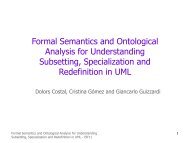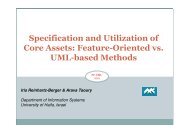booklet - ER 2011
booklet - ER 2011
booklet - ER 2011
You also want an ePaper? Increase the reach of your titles
YUMPU automatically turns print PDFs into web optimized ePapers that Google loves.
Conference Co-located Workshops<br />
Fifth International Workshop on Semantic and Conceptual Issues in GIS<br />
(SeCoGIS <strong>2011</strong>)<br />
MORE-BI brings together researchers in conceptual modeling, ontology engineering, knowledge representation,<br />
and reasoning with business analysts, developers, managers, and consultants involved in the definition of<br />
requirements for, development, use, and evolution of Business Intelligence (BI) systems. The aim is to initiate<br />
discussions and studies in ontologies, modeling languages, and reasoning methods relevant for the engineering of<br />
requirements for, and the engineering and specification of BI systems. These modeling and reasoning techniques<br />
should provide more precise and rich information for the end-user, bridging the gap between technical and usercentric<br />
tools for Business Intelligence. The workshop is the first of its kind to provide a forum for both research<br />
and practice in the conceptual modeling and reasoning needed for the engineering of BI systems, and encourages<br />
interdisciplinary discussions in all aspects of this field.<br />
Chairs: Roland Billen, Esteban Zimányi<br />
Date: November 1, <strong>2011</strong><br />
Website: http://cs.ulb.ac.be/conferences/secogis<strong>2011</strong>/<br />
Seventh International Workshop on Foundations and Practices of UML<br />
(FP-UML)<br />
The Unified Modeling Language (UML) has been widely accepted as the standard object-oriented (OO) modeling<br />
language for modeling various aspects of software and information systems. The UML is an extensible<br />
language, in the sense that it provides mechanisms to introduce new elements for specific domains if necessary,<br />
such as web applications, database applications, business modeling, software development processes, data warehouses.<br />
Furthermore, the latest version of UML 2.0 got even bigger and more complicated with more diagrams<br />
for some good reasons. Although UML providesdifferent diagrams for modeling different aspects of a software<br />
system, not all of them need to be applied in most cases. Therefore, heuristics, design guidelines, lessons<br />
learned from experiences are extremely important for the effective use of UML 2.0 and to avoid unnecessary<br />
complication. Also, approaches are needed to better manage UML 2.0 and its extensions so they do not become<br />
too complex too manage in the end. Already, the many UML extensions are not well integrated and the UML<br />
2.0 metamodel has become very complex.<br />
The objective of FP-UML’11 is to be an international forum for exchanging ideas on the latest and best<br />
practices of the UML in all aspects of software development. Papers focusing on the application of the UML in<br />
new domains; new experiences with UML 2.0; and foundations, theory, and UML 2.0 extensions will be highly<br />
encouraged. The workshop will be a forum for researchers and practitioners who are interested in the different<br />
facets related to the use of the UML for the development of software and information systems.<br />
Chairs: Guido Geerts (University of Delaware, USA) Matti Rossi (Aalto University, Finland)<br />
Date: November 2, <strong>2011</strong><br />
Website: http://www.aisvillage.com/fpuml<br />
<strong>ER</strong> Industrial Track (<strong>ER</strong>-IT <strong>2011</strong>)<br />
The <strong>ER</strong> Industrial Track is the forum for high quality presentations on innovative commercial software, systems<br />
and services for all facets of conceptual modeling methodologies and technologies as described in the list of topics<br />
of the <strong>ER</strong> <strong>2011</strong> conference. It also cover experiences with innovative applications. The focus is to underline the<br />
use of conceptual modeling related to commercial software or industrial-strength software. Important aspects<br />
to be highlithed are innovativeness of software and the potential of impact.<br />
Chairs: Alkis Simitsis, Hans Van Mingroot<br />
Date: November 2, <strong>2011</strong><br />
33




